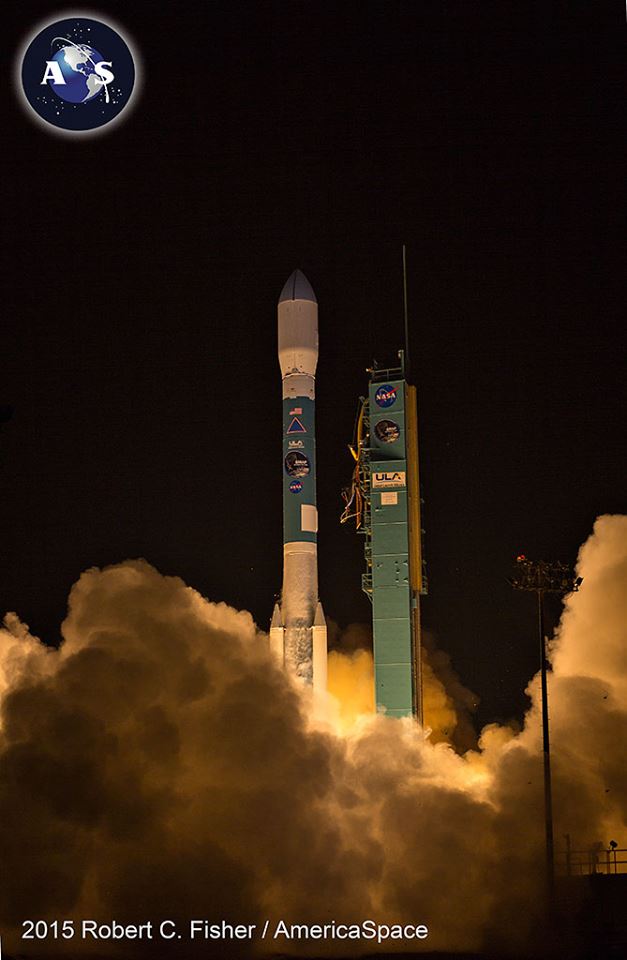
Last Saturday morning, AmericaSpace’s imagery team witnessed a rare pre-dawn liftoff of the highly reliable Delta II booster, carrying the Soil Moisture Active Passive (SMAP) satellite into a near-circular, near-polar orbit, from Vandenberg Air Force Base, Calif. However, it would appear that the end may be in sight for this venerable and highly reliable vehicle, which entered its 26th year of operations with the launch of SMAP. In contrast to the first decade of the present century, in which rapid-fire Delta II missions were conducted out of Vandenberg and Cape Canaveral Air Force Station, Fla., the withdrawal of the Air Force from the program means that there now remain only two NASA missions on the booster’s books, through 2018. Indeed, the flight of SMAP is likely to represent the last Delta II flight for at least the next two years.
The developmental history of the Delta II arose from the ashes of the Challenger tragedy, whose tumultuous aftermath saw the transfer of many shuttle payloads—including commercial, scientific, and military satellites—onto expendable launch vehicles. This transfer was hampered, however, by the fact that the shuttle was originally intended to replace all U.S. expendable boosters, and production lines for the Delta, Atlas-Centaur, and Titan 34D were in the process of being closed. Yet in April 1987, the reliable Delta was brought back into production, with the new Delta II initially to support a series of missions to launch the second generation of Global Positioning System (GPS) navigation and timing satellites, originally manifested for carriage aboard the shuttle, but later expanded by the Air Force and by NASA for a mixture of military and civilian payloads.
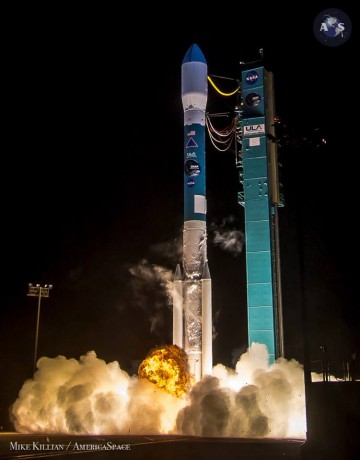
Since its conception, missions of the Delta II have been identified by a four-digit designation system. The first digit (either “6” or “7”) describes its membership of the first-generation 6000 or second-generation 7000 series of the vehicle, whilst the second digit (variously “3,” “4,” or “9”) denotes the number of strap-on solid-fueled rocket motors, the third digit (“2”) identifies the presence of a second stage, and the fourth and final digit details the nature of a third stage, whether entirely absent from the vehicle (“0”) or composed of a Payload Assist Module (PAM) with Star 48 motor (“5”) or Star 37FM motor (“6”).
The earliest incarnation of the Delta II was fabricated by McDonnell Douglas and, following the company’s merger with Boeing in 1997, by Boeing Integrated Defense Systems. More recently, since the formation of the joint Boeing/Lockheed Martin United Launch Alliance (ULA) in December 2006, U.S. Government requiring Delta II missions have been conducted under the auspices of this Centennial, Colo.-based operator, with commercial-sector payloads overseen by Boeing Launch Services.
At 1:29 p.m. EST on 14 February 1989, the maiden voyage of the Delta II got underway from Launch Complex (LC)-17 at Cape Canaveral Air Force Station. Flying in its “6925” configuration, the vehicle was powered uphill by its Rocketdyne-built RS-27 first-stage engine—fueled by liquid oxygen and a highly refined form of rocket-grade kerosene (known as “RP-1”)—and its nine Castor 4A strap-on motors. During the initial climb-out, six of the strap-on boosters were fired and, following their burnout and separation, the three remaining boosters were ignited to continue the climb to orbit. This Delta II configuration was capable of lofting a payload of up to 8,775 pounds (3,980 kg) into low-Earth orbit and up to 3,190 pounds (1,450 kg) into geostationary transfer orbit. Between February 1989 and October 1990, the 6925 delivered nine GPS Block II satellites into medium-Earth orbits with an altitude of about 13,450 miles (21,650 km).
Dovetailed into the GPS Block II manifest, the Delta II also delivered two payloads into low-Earth orbit, another into a medium orbit, two others into geostationary transfer orbit, and one spacecraft into a highly elliptical path to observe the Home Planet’s magnetosphere. The Naval Research Laboratory’s Low-Power Atmospheric Compensation Experiment (LACE), co-manifested with the Air Force’s Relay Mirror Experiment (RME), was launched into low-Earth orbit in February 1990 to undertake infrared, ultraviolet, and visible-light characterizations of laser emissions from ground-based sites and demonstrate stabilization, tracking, and pointing technologies for future anti-satellite systems. In June 1990, the joint U.S./German/British Roentgen Satellite (ROSAT) was also delivered into low-Earth orbit for almost a full decade of high-resolution X-ray and extreme ultraviolet astrophysics research.
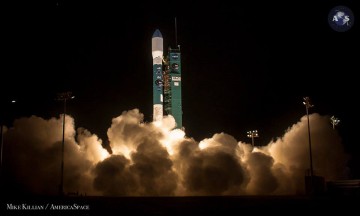
Other payloads included a pair of geostationary communications satellites. Indonesia’s Palapa B-2R—originally deployed by the shuttle as “Palapa B-2” on Mission 41B in February 1984, then retrieved and returned to Earth for refurbishment by the crew of Mission 51A the following November—was successfully launched in April 1990, followed by Britain’s Marco Polo-2 (later sold to Norway and renamed “Thor-1”) the following August. These were followed by the first two members of the International Maritime Satellite Organisation’s geostationary-orbiting Inmarsat-2 communications network in October 1990 and March 1991, NASA’s Extreme Ultraviolet Explorer (EUVE) in June 1992 and Japan’s Geotail in July 1992, the latter of which was co-manifested with the Diffuse Ultraviolet Explorer (DUVE). Geotail was delivered into a highly elliptical orbit of 35,700 x 248,500 miles (57,450 km x 399,950 km), enabling it to measure Earth’s magnetosphere and geomagnetic “tail,” whilst DUVE was delivered into a lower orbit of 133 x 877 miles (215 x 1,410 km) for seismological research and Earth observations.
With 17 successful launches under its belt, the 6000 series of the Delta II was retired following the Geotail/DUVE mission. By this stage, the 7000 series had picked up the baton. This vehicle benefited from the upgraded RS-27A first-stage engine—whose thrust of 236,900 pounds (107,500 kg) marked a significant enhancement over the 229,980 pounds (104,300 kg) of its predecessor—and from 40-inch-diameter (1,000-cm) Graphite Epoxy Motor (GEM)-40 strap-on boosters, which each punched out 112,200 pounds (50,900 kg) of propulsive yield. These enhancements allowed the Delta II to deliver larger and heavier payloads of up to 11,220 pounds (5,090 kg) into low-Earth orbit and up to 4,000 pounds (1,820 kg) into geostationary transfer orbit.
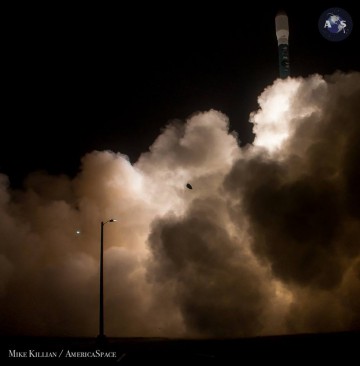
The first 7000-series mission got underway from LC-17 at the Cape at 4:39 p.m. EST on 26 November 1990 and successfully delivered the inaugural member of the GPS Block IIA constellation into medium-Earth orbit. Over the course of the following seven years, 18 further satellites of this family were launched, with further enhancements anticipated for the follow-on Block IIR (“Replenishment”) network. However, the first flight of a Block IIR ended in catastrophe on 17 January 1997, when a Delta II 7925 lifted off from LC-17 at 11:28 a.m. EST and was destroyed by remote command from the Flight Termination System (FTS), just 13 seconds into its flight. Although one earlier mission had failed to deliver its payload into the correct operational orbit, the GPS IIR-1 incident was the first total failure of a Delta II mission in 55 launches. (One previous launch, in August 1995, had suffered a GEM-40 separation failure, which sent the KoreaSat-1 communications satellite into a lower-than-intended orbit.) As circumstances transpired, the GPS IIR-1 incident would also mark the only outright failure of the Delta II in its 153-flight history, through January 2015.
In a spectacular fireball—and an understated “We have had an anomaly!” from the launch announcer—the Delta II vanished in a stream of burning shards, like a firework, when the FTS commanded explosive charges to destroy the vehicle. Having reached barely 1,600 feet (490 meters), this was the lowest-altitude failure of any launch vehicle in more than three decades. Debris impacted the Atlantic Ocean, the pad surface itself and an adjacent parking lot, resulting in the destruction of around 20 cars, and it was reported that store windows were damaged about 10 miles (16 km) from the launch site and the explosion was felt and heard from a distance of more than 25 miles (40 km). A subsequent investigation highlighted a crack in the casing of one of the GEM-40 strap-on boosters, which formed just six seconds after liftoff and caused the casing to rupture at T+12 seconds. Its debris struck one of the other GEM-40s, causing it to fail as well, after which the FTS was activated, destroying the first stage and the remaining boosters. The upper stages were boosted free from the inferno and the Range Safety Officer (RSO) manually destroyed them shortly thereafter.
However, after corrective actions, the Delta II returned successfully to flight, with missions from LC-17 at the Cape and from Space Launch Complex (SLC)-2 at Vandenberg Air Force Base, both in May 1997. The latter marked only its fourth mission from California, following on the heels of Canada’s Radarsat-1 remote-sensing satellite in November 1995, NASA’s Polar mission to explore Earth’s polar magnetosphere and aurora in February 1996, and the Ballistic Missile Defense Organization’s (BMDO) Midcourse Space Experiment (MSX) for missile-plume identification and tracking in April 1996. Over the years, both Vandenberg and the Cape would play host to Delta IIs with a range of payloads, including several dozen Iridium satellites, commercial geostationary-orbiting satellites, for various customers—including ASC, Satcom, Palapa, Galaxy, Koreasat, Thor, Skynet, GlobalStar, and the North Atlantic Treaty Organisation (NATO)—and a number of a classified payloads on behalf of the National Reconnaissance Office. Earth observation would prove a mainstay of many Delta II launches, including the Landsat-7 platform, the Jason-1 and Thermosphere Ionosphere Mesosphere Energetics and Dynamics (TIMED) spacecraft, the Ice, Cloud and Land Elevation Satellite (ICESat), and NASA’s Aqua and Aura missions.
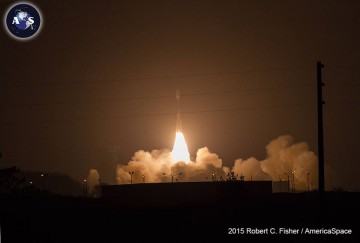
In November 1996, the Delta II was first employed to deliver a payload onto a trajectory to the Red Planet, when it lofted NASA’s Mars Global Surveyor. This was followed, a few days later, by Mars Pathfinder—bearing the hugely successful Sojourner rover—and subsequently by the ultimately ill-fated Mars Climate Orbiter in December 1998 and Mars Polar Lander in January 1999. In more recent years, Delta IIs have been responsible for boosting Mars Odyssey in April 2001, the twin Mars Exploration Rovers (MERs), dubbed “Spirit” and “Opportunity,” in June and July 2003, and the Phoenix Lander in April 2007. The second of the MER launches, interestingly, was also the maiden voyage of the Delta II Heavy, equipped with upgraded, 46-inch-diameter (1,200-cm) GEM-46 strap-on boosters, originally earmarked for the Delta III.
Other deep-space voyages and astronomical observatories have included the Near-Earth Asteroid Rendezvous (NEAR) in February 1996, the Far Ultraviolet Spectroscopic Explorer (FUSE) in June 1999, the Wilkinson Microwave Anisotropy Probe (WMAP) in June 2001, the Genesis solar wind sample-return spacecraft in August 2001, the ill-fated Comet Nucleus Tour (CONTOUR) in July 2002, the Spitzer Space Telescope in August 2003, the Mercury Surface, Space Environment, Geochemistry and Ranging (MESSENGER) mission to the Solar System’s innermost planet in August 2004, Deep Impact in January 2005, Dawn in September 2007, and Kepler in March 2009.
However, plans by the Air Force in 2007 to discontinue their use of the Delta II in favor of the Delta IV and Atlas V boosters were expected to see the vehicle phased out of service by 2011. Indeed, its flight rate dropped precipitously, from a peak of around seven or eight launches per annum, in the early part of the last decade, and in August 2009 it delivered its last dedicated Air Force payload into orbit. This was soon followed by the last mission of the “7400” series—with four strap-on GEM-40 boosters—in November 2010 and the sixth and final voyage of the Delta II Heavy in September 2011, the latter of which boosted the Gravity Recovery and Interior Laboratory (GRAIL) spacecraft duo to lunar orbit.
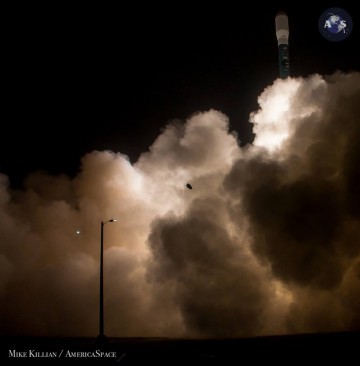
What was widely anticipated to be the Delta II’s final flight took place on 28 October 2011, with the launch of the Suomi National Polar-Orbiting Partnership (NPP) weather satellite, on behalf of the National Oceanic and Atmospheric Administration (NOAA). However, at around the same time, NASA announced that it had added the Delta II to its NASA Launch Services (NLS)-II contract, which provided for the delivery of payloads weighing about 550 pounds (250 kg) into minimum circular orbits of 125 miles (200 km). Four scientific missions—the Orbiting Carbon Observatory (OCO)-2, the Soil Moisture Active Passive (SMAP) and the forthcoming Ice, Cloud and Land Elevation Satellite (ICESat)-2 and Joint Polar Satellite System (JPSS)—received firm bookings for Delta II launches. The successful flight of OCO-2 in July 2014 ended an almost three-year hiatus in operations for the long-serving booster.
Last weekend’s successful flight of SMAP marked the 98th consecutive mission success for a Delta II, meaning that if ICESat-2 and JPSS also reach orbit without incident, the vehicle will amass an impressive and unbroken record of 100 perfect launches. However, these two missions—with ICESat-2 designed to measure ice-sheet mass elevation, land topography, and vegetation characteristics and JPSS tasked with improving the forecasting of weather and climate events—are not expected to fly until 2017 or perhaps later. Unless NASA seeks to expand its NLS-II contract with additional Delta II launches, it appears likely that ICESat-2 and JPSS will round out the vehicle’s impressive career, hopefully, with a 100-flight unbroken chain of mission successes.
Want to keep up-to-date with all things space? Be sure to “Like” AmericaSpace on Facebook and follow us on Twitter: @AmericaSpace
Missions » SMAP »


